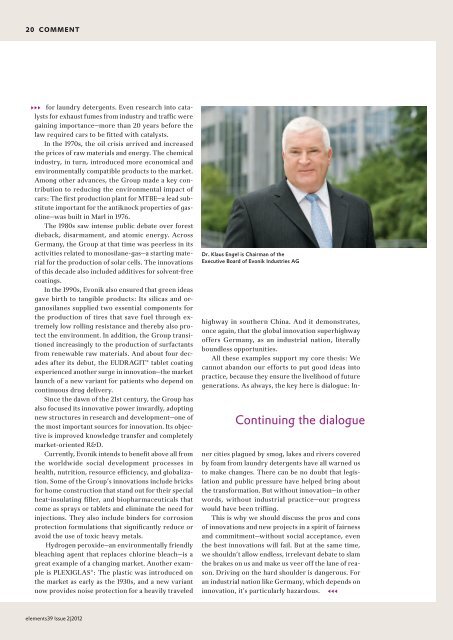Download - Evonik Industries
Download - Evonik Industries
Download - Evonik Industries
You also want an ePaper? Increase the reach of your titles
YUMPU automatically turns print PDFs into web optimized ePapers that Google loves.
20 CoMMent<br />
333 for laundry detergents. Even research into catalysts<br />
for exhaust fumes from industry and traffic were<br />
gaining importance—more than 20 years before the<br />
law required cars to be fitted with catalysts.<br />
In the 1970s, the oil crisis arrived and increased<br />
the prices of raw materials and energy. The chemical<br />
industry, in turn, introduced more economical and<br />
environmentally compatible products to the market.<br />
Among other advances, the Group made a key contribution<br />
to reducing the environmental impact of<br />
cars: The first production plant for MTBE—a lead substitute<br />
important for the antiknock properties of gasoline—was<br />
built in Marl in 1976.<br />
The 1980s saw intense public debate over forest<br />
dieback, disarmament, and atomic energy. Across<br />
Germany, the Group at that time was peerless in its<br />
activities related to monosilane-gas—a starting material<br />
for the production of solar cells. The innovations<br />
of this decade also included additives for solvent-free<br />
coatings.<br />
In the 1990s, <strong>Evonik</strong> also ensured that green ideas<br />
gave birth to tangible products: Its silicas and organosilanes<br />
supplied two essential components for<br />
the production of tires that save fuel through extremely<br />
low rolling resistance and thereby also protect<br />
the environment. In addition, the Group transitioned<br />
increasingly to the production of surfactants<br />
from renewable raw materials. And about four decades<br />
after its debut, the EUDRAGIT® tablet coating<br />
experienced another surge in innovation—the market<br />
launch of a new variant for patients who depend on<br />
continuous drug delivery.<br />
Since the dawn of the 21st century, the Group has<br />
also focused its innovative power inwardly, adopting<br />
new structures in research and development—one of<br />
the most important sources for innovation. Its objective<br />
is improved knowledge transfer and completely<br />
market-oriented R&D.<br />
Currently, <strong>Evonik</strong> intends to benefit above all from<br />
the worldwide social development processes in<br />
health, nutrition, resource efficiency, and globalization.<br />
Some of the Group’s innovations include bricks<br />
for home construction that stand out for their special<br />
heat-insulating filler, and biopharmaceuticals that<br />
come as sprays or tablets and eliminate the need for<br />
injections. They also include binders for corrosion<br />
protection formulations that significantly reduce or<br />
avoid the use of toxic heavy metals.<br />
Hydrogen peroxide—an environmentally friendly<br />
bleaching agent that replaces chlorine bleach—is a<br />
great example of a changing market. Another example<br />
is PLEXIGLAS®: The plastic was introduced on<br />
the market as early as the 1930s, and a new variant<br />
now provides noise protection for a heavily traveled<br />
elements39 Issue 2|2012<br />
Dr. Klaus engel is Chairman of the<br />
executive Board of evonik <strong>Industries</strong> AG<br />
highway in southern China. And it demonstrates,<br />
once again, that the global innovation superhighway<br />
offers Germany, as an industrial nation, literally<br />
boundless opportunities.<br />
All these examples support my core thesis: We<br />
cannot abandon our efforts to put good ideas into<br />
practice, because they ensure the livelihood of future<br />
generations. As always, the key here is dialogue: In-<br />
Continuing the dialogue<br />
ner cities plagued by smog, lakes and rivers covered<br />
by foam from laundry detergents have all warned us<br />
to make changes. There can be no doubt that legislation<br />
and public pressure have helped bring about<br />
the transformation. But without innovation—in other<br />
words, without industrial practice—our progress<br />
would have been trifling.<br />
This is why we should discuss the pros and cons<br />
of innovations and new projects in a spirit of fairness<br />
and commitment—without social acceptance, even<br />
the best innovations will fail. But at the same time,<br />
we shouldn’t allow endless, irrelevant debate to slam<br />
the brakes on us and make us veer off the lane of reason.<br />
Driving on the hard shoulder is dangerous. For<br />
an industrial nation like Germany, which depends on<br />
innovation, it’s particularly hazardous. 777
















